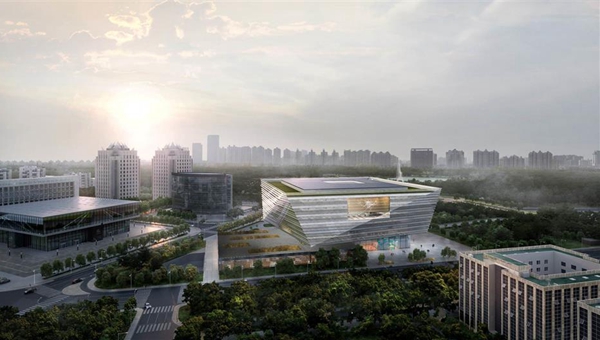
What will libraries of the future be like? People-oriented,
environmentally friendly, interconnected, inclusive, intelligent and
innovative — and the east branch of Shanghai Library aims to show how.
Construction of the east branch is scheduled to start on Wednesday in the Pudong New Area, marking a milestone in the city’s efforts in building itself into an international cultural metropolis.
Shanghai Library's east branch will sit between Shanghai Science and Technology Museum and Century Park, the largest park in the city. The branch will be surrounded by Century Avenue and Yingchun, Hehuan and Jinxiu Roads.
It is expected to be constructed during the following 1,005 days, and handed over on July 30, 2020 and open to the public at the end of that year.
After its completion, it will form part of a cultural assembly of facilities in the area, such as the Shanghai Science and Technology Museum, the Oriental Arts Center, the east branch of the Shanghai Museum and Pudong Expo.
Fifteen architectural companies from home and abroad bid to design the library, with Denmark's Schmidt Hammer Lassen Architects winning out with its open, friendly and simple design.
“The design is people-oriented, open and flexible, environment-friendly and interconnected,” said Chen Chao, the curator of Shanghai Library. “Once completed, it will meet all peoples' demands for functions of an epoch-making public library.”
Located on a large piece of green land, covering a construction area of 115,000 square meters, the building will look like “a singular monolithic object floating above the tree canopy, or a well carved jade in a forest,” according to Chen.
The facade of the library will comprise clear, insulated glass and have seven floors above ground and two beneath. The new library will serve as a public space for reading and lending books — and as a community to connect users with knowledge, experiences, and innovation.
“One reason for us to choose the design by SHL is it treats a modern library not only as a place for storing and lending books, but also a place for people to stay and make social interaction,” said Chen, "a shift from collection to connection.”
Chen said the
current Shanghai Library on Huaihai Road was designed to be a
research-type library and less than 25 percent of its total area was
open to the public.
“Though we have added seats on corridors, there are only fewer than 2,000 seats in the downtown library now,” he said. “It’s more and more difficult to host the increasing visitors. Last year alone, it had 3.35 million visitors.”
The east branch will have about 6,000 seats and be able to serve 4 million visitors and host more than 200 lectures and 1,000 other activities. There will be about 4.8 million books on the open shelves.
“After the east branch is opened, it will bear the main function of public service, including lending and reading books, as well as hosting public activities,” said Chen. “The downtown library will focus more on academic research, but will retain basic services, such as circulation of books.”
He emphasized that the new building will be a hybrid library, where readers could enjoy both paper and digital reading.
Chen also said that it will be inclusive, intelligent and innovative with five main functions — a resource center, a knowledge exchange center, a technology experience center, a think tank and an international communication platform.
There will be dedicated pavilions for children, disabled people and senior citizens.
There will also be themed pavilions, such as choreography, genealogy, arts, music and frontier technology for visitors to read, watch performances and attend interactive and experience activities.
For innovators, there will be advanced technologies and equipment in the frontier science pavilion and the innovation space.
Academic researchers can also apply for separate research and discussion areas. A think-tank service will be available for researchers, business starters and decision-makers.
There will be areas open to reading clubs for promoting public reading.
Robots will also be introduced into the modern venue to guide visitors and help library staff with book management.
Zhang Lei, a man in his 30s living on Jinxiu Road, said he was looking forward to the opening of the modern library.
“It sounds terrific that we can read and have fun there,” he said. “I can imagine that my whole family could spend a whole day in it after it’s opened.”
